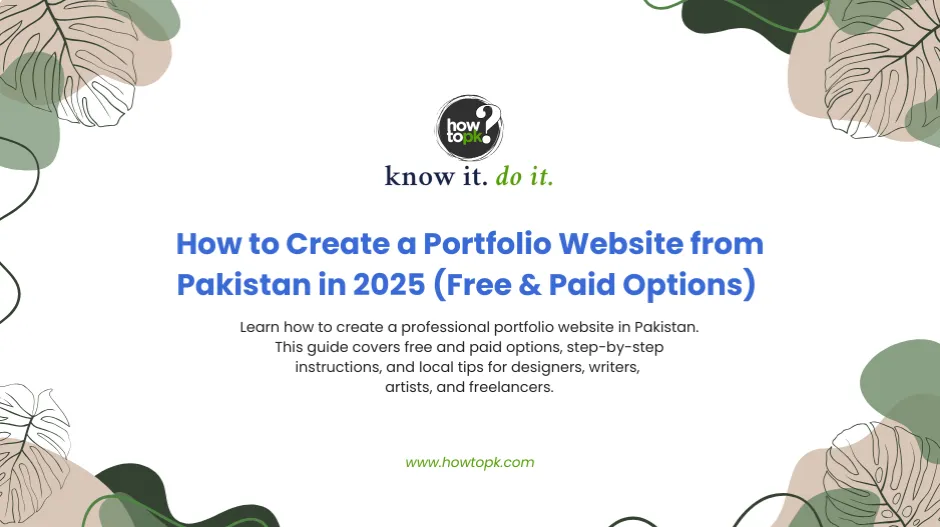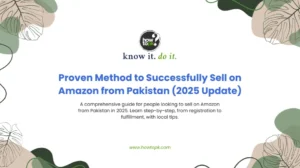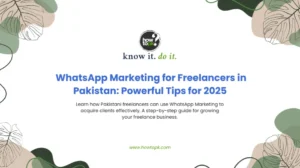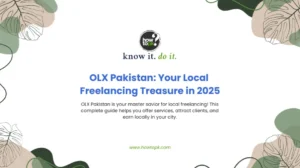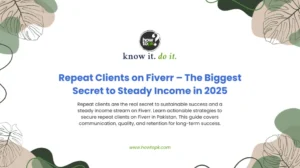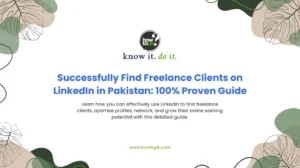In today’s competitive world, having a strong online presence is crucial, especially if you’re a freelancer, artist, designer, writer, or anyone looking to showcase their work and attract clients. A portfolio website acts as your digital storefront, accessible 24/7, allowing you to display your best projects, highlight your skills, and tell your unique story. For professionals in Pakistan, creating a portfolio website can open doors to local and international opportunities.
This comprehensive guide will walk you through everything you need to know about building a professional portfolio website in Pakistan, covering both free and paid options. We’ll break down each step, offer practical advice, and help you choose the best path for your needs and budget.
Why Do You Need a Portfolio Website in Pakistan?
A portfolio website isn’t just a fancy online resume; it’s a powerful tool that offers numerous benefits:
- Showcase Your Work Visually: Unlike a traditional CV, a website allows you to visually present your projects, whether they’re graphic designs, written articles, coding projects, or photographs. This makes a much stronger impression.
- Establish Credibility and Professionalism: A well-designed portfolio website instantly boosts your credibility. It shows potential clients that you are serious about your craft and have a professional approach.
- Reach a Wider Audience: Your website can be found by anyone, anywhere in the world. This is especially beneficial for Pakistani freelancers looking to attract international clients and expand their reach beyond local markets.
- Control Your Narrative: You dictate how your work is presented, what information is highlighted, and how your brand story is told. This level of control is invaluable for personal branding.
- Generate Leads and Enquiries: A dedicated contact form or clear contact information on your website makes it easy for interested clients to get in touch with you directly, converting visitors into potential leads.
- Stand Out from the Crowd: In a market flooded with talent, a unique and well-curated portfolio website helps you differentiate yourself from competitors.
- Always Available: Your portfolio is accessible around the clock, even when you’re asleep or busy with other tasks. Clients can browse your work at their convenience.
Step 1: Define Your Purpose and Target Audience
Before you even think about designs or platforms, take a moment to understand what you want your portfolio website to achieve and who you want to reach. This clarity will guide all your subsequent decisions.
- Ask yourself: What do I want visitors to do when they land on my site (e.g., contact me, view my case studies, download my resume)?
- Consider your audience: Who are they? What are their needs? What problems can you solve for them? Think about their industry, location, and budget.
- Brainstorm keywords: What terms would your ideal clients use to find someone like you? This helps with later optimization.
Common Mistake: Jumping straight into building without a clear plan. This often leads to a generic, ineffective portfolio that doesn’t resonate with the right people.
Tip for Pakistan: If you’re targeting local businesses, think about common business practices and communication styles in Pakistan. If international, consider global best practices.
Step 2: Curate Your Best Work
Your portfolio is only as strong as the work you showcase. This step is about selecting, refining, and presenting your projects in the most compelling way.
- Select your top 5-10 projects: For each, prepare high-quality images, screenshots, videos, or links to live work.
- Write compelling case studies: Don’t just show the final product. Explain the problem you solved, your process, your role in the project, the tools you used, and the results achieved. Quantify results if possible (e.g., “increased engagement by 30%”).
- Get permissions: If you worked for clients, ensure you have permission to display the work publicly. If not, consider creating personal projects specifically for your portfolio.
- Organize your work: Group similar projects together (e.g., “Web Design,” “Branding,” “Content Writing”).
Common Challenge: Not having enough “professional” work. If you’re just starting out, create speculative projects or offer pro-bono work to build your portfolio. Take online courses that include project-based learning.
Tip for Pakistan: Many Pakistani professionals gain experience through local internships or family businesses. Don’t underestimate these experiences; articulate your contributions clearly in your case studies.
Step 3: Choose Your Platform (Free vs. Paid)
This is where your budget and technical comfort level come into play. There are excellent free options for beginners and more robust paid solutions for those who need greater control and features.
Free Options: Get Started Without Spending a Rupee
Free platforms are fantastic for those on a tight budget, students, or anyone wanting to test the waters before investing. While they offer less customization and often include branding of the platform itself, they’re a great starting point.
- Behance (for creatives like designers, artists, photographers):
- Create a free account.
- Upload your projects with descriptions, images, and videos.
- Organize your work into separate projects or collections.
- You’ll get a profile URL (e.g., behance.net/yourusername). It’s a widely recognized platform in the creative industry.
- Dribbble (similar to Behance, more focused on UI/UX, graphic design):
- You typically need an invite to post work initially, but you can create a profile and showcase “shots” (small snippets of work). It’s excellent for designers.
- WordPress.com (for writers, bloggers, general portfolios):
- Sign up for a free plan.
- Choose a free theme that suits a portfolio layout.
- Create pages for your “About,” “Portfolio,” and “Contact.”
- Your site will be on a subdomain (e.g., https://www.google.com/search?q=yourname.wordpress.com).
- While it’s not as robust as a self-hosted WordPress site, it’s good for text-heavy portfolios.
- Wix / Canva (drag-and-drop website builders with free plans):
- These platforms offer intuitive drag-and-drop interfaces.
- Sign up for a free account.
- Select a free portfolio template.
- Customize with your content, images, and text.
- Your site will have their branding and a subdomain (e.g., yourname.wixsite.com/mysite).
- Google Sites (simple, integrated with Google ecosystem):
- If you have a Google account, you can easily create a simple website.
- It’s very basic but effective for a straightforward online resume or small portfolio.
Common Pitfall: Free options often come with limitations like visible branding, limited storage, no custom domain (e.g., .com, .pk), and fewer customization choices. This can make your portfolio look less professional in the long run.
Tip for Pakistan: Many Pakistani professionals start with platforms like Behance or Facebook pages to display work due to their widespread use and low barrier to entry. Consider these as initial steps, but aim for a more professional solution eventually.
Paid Options: Investing in Professionalism
Paid options offer far more control, customization, professional features, and a stronger brand identity. They are highly recommended for anyone serious about attracting high-paying clients or building a long-term career.
Consider self-hosted WordPress, dedicated portfolio builders, or hiring a local web developer.
Step 3.1: Choose a Domain Name
- Select a unique name for your website. This is your address on the internet (e.g., yourname.com, yourcompany.pk).
- A custom domain name enhances your brand, makes your site easy to remember, and looks professional.
- brainstorm names: Ideally, it should be your name (e.g., “https://www.google.com/search?q=AliAhmedDesigns.com”) or a relevant, memorable phrase.
- Check availability: Use a domain registrar’s search tool. Many local and international hosting providers in Pakistan offer domain registration services.
- Consider extensions: While .com is global, a .pk domain can signal local presence. Other options include .net, .org, or more specific ones like .design, .art.
- Purchase the domain: Prices vary but generally range from PKR 1,800 to PKR 3,500 per year for common extensions.
Step 3.2: Choose a Web Hosting Provider
- Select a company that will store your website files and make them accessible on the internet.
- Reliable hosting ensures your website is fast, secure, and always online. Slow or unreliable hosting can deter visitors and harm your reputation.
- Research local Pakistani hosting providers: Many reputable local companies offer competitive prices and excellent customer support in Urdu/English. This can be a huge advantage for troubleshooting.
- Look for key features:
- SSD Storage: For faster website loading.
- Bandwidth: Sufficient data transfer for your visitors.
- Uptime Guarantee: Aim for 99.9% uptime.
- Customer Support: 24/7 support is ideal.
- SSL Certificate: Essential for security (HTTPS) and SEO. Many hosts offer a free one.
- WordPress Compatibility: Ensure they offer easy WordPress installation (often one-click installers).
- Pricing: Shared hosting plans can range from PKR 1,500 to PKR 10,000 per year, depending on features.
- Purchase a hosting plan: Start with a shared hosting plan; it’s usually sufficient for a portfolio website.
Step 3.3: Install WordPress
- Once you have domain and hosting, install the WordPress software.
- WordPress is incredibly versatile, user-friendly, and powers a huge percentage of websites worldwide. Its vast ecosystem of themes and plugins makes customization easy.
- Most hosting providers offer a “one-click WordPress install” feature in their control panel (cPanel or similar). Follow their instructions.
- Alternatively, you can manually install it, but the one-click method is much simpler for beginners.
How to Do It (Dedicated Portfolio Builders – Easier but Less Flexible):
These platforms are designed specifically for portfolios and often include hosting and a domain (or subdomain) in their plans. They are usually more expensive than basic shared hosting for WordPress but offer an easier, more streamlined experience.
- Squarespace: Known for its beautiful, minimalist templates ideal for visual portfolios. It’s an all-in-one platform with drag-and-drop editing.
- Wix (Premium Plans): Offers a huge variety of templates and a user-friendly drag-and-drop editor. Premium plans remove Wix branding and allow custom domains.
- Adobe Portfolio: If you have an Adobe Creative Cloud subscription, this is included. It’s integrated with Behance and allows for quick creation of a visually appealing portfolio.
- Pixpa: Another excellent option for creatives, offering e-commerce integration if you plan to sell your work.
Cost: These platforms typically charge monthly or annual fees, ranging from $10-$30 USD per month (PKR 2,800 – PKR 8,500 approx.), which can be a significant cost over time compared to self-hosted WordPress for a simple portfolio.
How to Do It (Hiring a Local Web Developer):
If you have the budget and prefer a completely hands-off approach, you can hire a professional web developer in Pakistan to build your portfolio website for you.
- Find a reputable freelance web developer or a small web agency.
- They can create a fully customized, unique, and highly optimized website tailored to your exact needs. This saves you time and ensures a professional outcome.
- Search for “web developer Pakistan” or “website design Karachi/Lahore/Islamabad.”
- Ask for their portfolio and client testimonials.
- Clearly define your requirements and budget.
- Expect costs to range from PKR 25,000 to PKR 100,000+ for a custom portfolio website, depending on complexity and features.
Tip for Pakistan: Many talented web developers and agencies are available at competitive rates compared to international markets. Look for someone who understands your creative field.
Step 4: Design Your Portfolio Website
Once you’ve chosen your platform, it’s time to bring your vision to life. The design should be clean, intuitive, and reflective of your personal brand.
For self-hosted WordPress:
- Choose a Responsive Theme:
- Select a WordPress theme specifically designed for portfolios. “Responsive” means it looks good on all devices (desktops, tablets, mobiles).
- A good theme provides the foundational structure and styling. Responsiveness is crucial as many visitors will browse on their phones.
- Go to Appearance > Themes in your WordPress dashboard. Search for “portfolio,” “creative,” or “freelancer” themes. Popular free options include Astra, Kadence, Neve. Paid themes (premium themes) like those from ThemeForest offer more features and better support.
- Customize Your Theme:
- Adjust colors, fonts, layout, and add your branding elements (logo, favicon).
- To make the theme uniquely yours and align it with your personal brand. Consistency builds recognition.
- Use the WordPress Customizer (Appearance > Customize) to make visual changes without coding. Many themes come with powerful theme options panels.
- Install Essential Plugins:
- Add plugins for specific functionalities.
- Plugins extend WordPress’s capabilities, adding features like contact forms, SEO tools, and security.
- Go to Plugins > Add New. Recommended plugins:
- Elementor or Beaver Builder: For drag-and-drop page building if your theme’s customizer isn’t enough.
- Contact Form 7 or WPForms: For creating a contact form.
- Yoast SEO or Rank Math: For search engine optimization.
- WP Super Cache or LiteSpeed Cache: For website speed optimization.
- UpdraftPlus: For website backups.
- Wordfence Security or Sucuri Security: For website security.
For Website Builders like Wix, Squarespace:
- Select a Template: Browse their extensive template libraries and pick one that resonates with your style and type of work.
- Drag-and-Drop Editing: Use their intuitive editors to add sections, images, text, and rearrange elements. These builders are designed to be very user-friendly, requiring no coding.
- Built-in Features: Most portfolio builders come with built-in contact forms, image galleries, and other features, so you might not need separate “plugins.”
Common Mistake: Over-designing or using too many fancy animations. Keep it clean, professional, and easy to navigate. Simplicity often works best.
Tip for Pakistan: Ensure your chosen fonts are readable and that your color palette is culturally appropriate if targeting local clients, or universally appealing for international audiences.
Step 5: Create Essential Pages
Every professional portfolio website needs a few core pages to be complete and effective. Build out your Home, Portfolio/Work, About, and Contact pages. These pages provide visitors with key information about you, your skills, your work, and how to reach you, guiding them through your site effectively.
- Home Page:
- Purpose: Hook visitors, introduce yourself briefly, and direct them to your best work or relevant sections.
- Content: A captivating headline, a brief introduction, a strong call to action (e.g., “View My Portfolio”), and perhaps a rotating display of your top projects.
- Portfolio / Work Page(s):
- Purpose: The core of your website, where you showcase your projects.
- Content: Clear thumbnails or links to each project. Each project should have its own dedicated page (case study) with detailed descriptions, images, process, and results. Categorize your work if you have a diverse skill set.
- About Page:
- Purpose: Tell your story, highlight your expertise, and build trust.
- Content: A professional headshot, a brief bio (your journey, philosophy, passion), your skills list, education, experience, and perhaps a personal touch. Make it personable, not just a resume.
- Services Page (Optional but Recommended):
- Purpose: Clearly define what services you offer.
- Content: List your services with brief descriptions, what problems they solve for clients, and what makes you unique.
- Contact Page:
- Purpose: Make it easy for potential clients to reach you.
- Content: A contact form, your professional email address, links to professional social media (LinkedIn, Behance), and possibly your phone number. Avoid publishing your personal mobile number publicly unless you’re comfortable with it.
Common Mistake: Incomplete pages or generic “lorem ipsum” text. Ensure all content is polished and relevant before launching.
Tip for Pakistan: Many professionals in Pakistan use WhatsApp for initial contact. You can include a WhatsApp link on your contact page if you prefer, but always ensure a professional alternative like an email or contact form is available.
Step 6: Optimize for Search Engines (SEO Basics)
Once your website is built, you want people to find it. Search Engine Optimization (SEO) helps your portfolio rank higher in search results.
Higher visibility means more potential clients finding your work without you having to actively market it. It’s like having your shop on a main road rather than a hidden alley.
- Keyword Research:
- Identify words and phrases potential clients would type into Google to find someone with your skills.
- To understand what your audience is searching for.
- Think like a client. If you’re a “Lahore graphic designer,” those are keywords. If you’re a “freelance content writer Pakistan,” use that.
- On-Page SEO:
- Incorporate your keywords naturally into your page titles, headings (H1, H2), content, image alt text, and meta descriptions.
- This tells search engines what your page is about.
- Use an SEO plugin (like Yoast SEO or Rank Math for WordPress) to guide you through this. For other builders, look for “SEO settings” for each page.
- Mobile Responsiveness:
- Ensure your website looks great and functions perfectly on mobile phones.
- Google prioritizes mobile-friendly websites. Plus, most people browse on their phones.
- Test your website on various devices. Most modern themes and builders are responsive by default.
- Website Speed:
- Optimize your site for faster loading times.
- Users and search engines prefer fast websites.
- Compress images before uploading, use caching plugins (for WordPress), and choose a reliable hosting provider.
- Google My Business (for local businesses):
- If you operate locally (e.g., a photographer in Karachi), create and optimize a Google My Business profile.
- To appear in local search results and Google Maps.
- Sign up for Google My Business and verify your Pakistani business address.
Common Challenge: Overstuffing keywords. Don’t force keywords unnaturally into your text; it sounds robotic and can harm your rankings. Write for humans first, then optimize for search engines.
Tip for Pakistan: Consider optimizing for local searches (e.g., “web designer Islamabad,” “artist Lahore”).
Step 7: Launch and Promote Your Portfolio
Your website is ready! Now it’s time to make it public and tell the world about it.
A beautiful website is useless if no one knows it exists. Promotion drives traffic, which can lead to new opportunities.
- Final Review:
- Before going live, check every link, image, form, and piece of text. Get a friend to review it too.
- To catch any errors or broken elements that could detract from your professionalism.
- Make it Live:
- If using a website builder, click the “Publish” button. If self-hosting, your site might already be live, but ensure all “coming soon” or “maintenance mode” settings are off.
- Share on Social Media:
- Announce your new portfolio on LinkedIn, Facebook, Instagram, Twitter, and other relevant platforms where your audience hangs out.
- To leverage your existing network and generate initial traffic.
- Write a compelling post, include a direct link, and perhaps a screenshot or video of your site.
- Update Your Bios:
- Add your portfolio website link to all your online profiles (freelance marketplaces, social media bios, email signatures).
- To ensure anyone who encounters you online can easily find your work.
- Network:
- Share your website with colleagues, mentors, and potential collaborators in your industry, both online and offline.
- Word-of-mouth referrals are powerful.
- Consider Paid Promotion (Optional):
- If you have a marketing budget, consider running targeted ads on social media or Google.
- To reach a specific audience quickly and generate leads faster.
- Learn about Facebook Ads or Google Ads for your target audience in Pakistan or abroad.
Common Challenge: Launching and then forgetting. Your portfolio needs ongoing attention to stay relevant and attract new opportunities.
Tip for Pakistan: Leverage local online communities and freelance groups on Facebook or WhatsApp to share your new portfolio. Many Pakistani professionals find opportunities through these networks.
Step 8: Maintain and Update Regularly
A portfolio website is a living document. It needs to evolve as your skills and experience grow.
To keep your content fresh, showcase your latest and greatest work, ensure all links are working, and maintain security. An outdated portfolio looks unprofessional.
- Add New Projects:
- As you complete new, impressive work, add it to your portfolio.
- To show your growth and keep your content current.
- Update Your About Page:
- Refresh your bio, skills, and experience as you gain new expertise.
- To reflect your current professional journey.
- Check for Broken Links:
- Periodically click through all your links to ensure they still work.
- Broken links create a poor user experience and can harm your SEO.
- Security and Backups (for self-hosted WordPress):
- Regularly update WordPress core, themes, and plugins. Perform backups.
- To protect your website from security vulnerabilities and data loss.
- Set up automatic backups with a plugin or through your hosting provider. Always update when new versions are available.
- Analyze Performance (Optional):
- Use tools like Google Analytics to see who visits your site, how long they stay, and which pages they view.
- To understand what’s working and identify areas for improvement.
Common Pitfall: Neglecting updates. A stagnant portfolio gives the impression that you’re no longer actively working or improving.
Tip for Pakistan: Many freelance professionals in Pakistan are constantly evolving their skills. Make sure your portfolio reflects this continuous learning and growth.
Conclusion
Creating a portfolio website in Pakistan, whether you choose a free platform to start or invest in a paid, customized solution, is a powerful step towards advancing your career. It’s your digital handshake, your online resume, and your 24/7 sales representative, all rolled into one.
Start small if you need to, but always aim for professionalism and quality. By following these steps and dedicating time to curate and present your best work, you’ll build a strong online presence that attracts the right opportunities and helps you stand out in Pakistan’s dynamic professional landscape.
Resources
- Free Portfolio Platforms
- Behance
- Dribbble
- WordPress.com
- Wix (Free Plan)
- Canva Website Builder
- Google Sites
- Crevado
- Portfoliobox (Free Plan)
Paid Portfolio Builders
Domain & Hosting Providers in Pakistan
WordPress Plugins (for Self-Hosted WordPress)
- Elementor
- Beaver Builder
- Contact Form 7
- WPForms
- Yoast SEO
- Rank Math
- WP Super Cache
- LiteSpeed Cache
- UpdraftPlus
- Wordfence Security
- Sucuri Security
Analytics Tool
Local Communities
- Explore various Facebook groups and online forums dedicated to freelancers and creative professionals in Pakistan.

